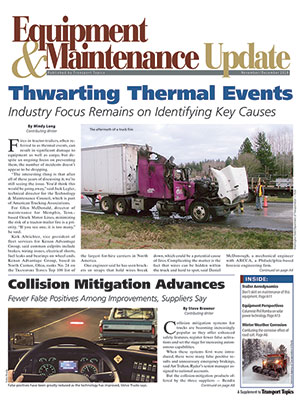Tire Monitoring and Inflation Systems Can Lead to Fuel Savings, Longer Tire Life

Tire failures remain the No. 1 reason for roadside assistance calls. And most tire-related problems come from underinflation as a result of leaks, punctures or just poor maintenance programs.
More than 85% of tire-related downtime is caused by underinflation, according to Aperia Technologies, which makes the Halo automatic tire inflation system. Underinflation also brings other costs: Tire life is compromised and fuel economy is reduced.

Sturgess
In a white paper accompanying the launch of its Spicer Optima inflation system, Dana states that underinflation by 10 psi can result in as much as a 1% fuel-efficiency penalty. And tires are the second-most frequent cause of inspection citations.
So the monitoring of tire pressure is crucial to trouble-free and efficient operation, whether it is an owner-operator’s truck or a truck in a fleet of thousands.
Tire pressure checks are a maintenance operation, but on a daily basis, they are the driver’s responsibility. But his or her pay is linked to miles, so it makes sense to make the most of their time by ensuring the inspection process is as easy as possible — even automating tire pressure maintenance entirely.
Simple visual systems can show tire pressure deviations through dust caps with built-in indicators. These “smart” tire pressure caps are usually pre-set to the required tire pressure. Search for heavy truck or recreational vehicle types to get the threshold pressure appropriate to truck tires.

- Collision Mitigation Advances
- Thwarting Thermal Events
- Here Comes the Sun
- The Analytical Dilemma
- Preventive Maintenance Helps Stop Rust Due to Road Salt
- Investigating Thermal Event Causes Is Crucial, Experts Say
- Tire Monitoring and Inflation Systems Can Lead to Fuel Savings, Longer Tire Life
- Seeking Alternative Solutions to Salt
- Don't Skirt Proper Maintenance on Trailer Aero Devices, Experts Say
A step up is the simple replacement cap, such as the LED AirGuard by Real Wheels, which senses the pressure in the correctly inflated tire and, should the pressure fall, sends out a flashing LED signal. It’s easy to see on a walkaround inspection.
Even easier for the driver are systems such as the Doran 360 from Doran Manufacturing, which has the pressure sensor information relayed to a small, on-dash monitor. These report in real time and if a tire loses air, the driver gets an alarm. This system is designed for heavy-duty applications and may be available as a data-book option on new trucks.
Better yet are systems that monitor tire pressure, then automatically act to maintain pressure inside the tire while warning the driver there’s something wrong in the onboard tire management system. That is the difference between tire pressure monitoring systems (TPMS) and automatic tire inflation systems (ATIS).
One of the drawbacks of TPMS is driver behavior — the driver still must act to attend to the leaking tire. This can take several hours and is money out of the driver’s pocket. So the scene is set for a gamble: Can the driver complete his delivery before the truck goes down with a blown-out tire?
Automatic tire pressure control is the better, though more complicated and expensive, technology. Fortunately, new products are available that offer the benefits of full-time control with additional features.
Trailer-only systems from suppliers such as Pressure Systems International have been around for decades. PSI also includes its wheel-end monitor that identifies problems with overheated bearings or dragging brakes. Hendrickson’s TireMaax Pro also is a trailer-axle system that functions as an equalizer for duals and will air down tires if they become overinflated from heat.
The recent tire inflation system introduced by Dana works on all axles — truck and trailer. The system reports to the back office with tire pressure history so that any trends, such as a continually slow-leaking tire, can be addressed during maintenance.
Most of the inflation systems use on-vehicle compressed air to maintain pressure. But Aperia’s system generates its own air pressure as the truck runs down the road. Attached to the wheel hub, the system pumps air to any dual tire pair or ultra-low profile single. About a year ago, the company announced that it can be installed with aerodynamic wheel covers for additional fuel savings.
These tire systems have a payback that can be three months but generally the payback is within a year. All can help reduce driver aggravation and lead to fuel savings and longer tire life.

